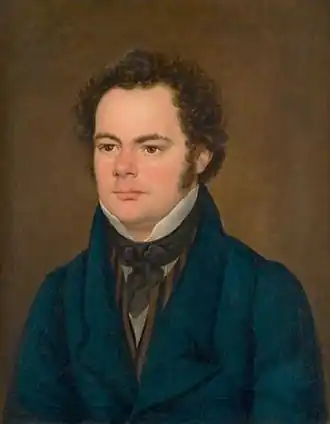Mass No. 1 (Schubert)
| Mass No. 1 | |
|---|---|
| by Franz Schubert | |
 Lichtental Parish Church. The mass was composed for the church's centennial. | |
| Key | F major |
| Catalogue | D 105 |
| Form | Missa solemnis |
| Composed | 1814 |
| Performed | 25 September 1814: Lichtental |
| Movements | 6 |
| Vocal | SATB choir and soloists |
| Instrumental | orchestra and organ |
Mass No. 1 in F major, D 105, is a mass composed by Franz Schubert in 1814. It is scored for two soprano soloists, two tenor soloists, alto and bass soloists, SATB choir, oboe, clarinet, bassoon, 2 horns, violin I and II, viola, and basso continuo (cello, double bass and organ). It was the first of Schubert's masses to be performed,[1] and is of the missa solemnis type.[2]
Background

The mass was composed for the centennial celebration of the parish church of Lichtental, now part of Vienna.[1] The Schuberts' family church, it is also known as Schubertkirche (Schubert church).[3] Schubert received an invitation to compose a mass for the anniversary in May 1814.[4] The premiere was conducted on 25 September with an estimated 62 performers, a large contingent for contemporary performances.[4] The composer's brother Ferdinand played the organ, Michael Holzer served as choirmaster, Joseph Mayseder served as concertmaster, Therese Grob sang the soprano solo, and Schubert conducted.[5] Schubert's teacher Antonio Salieri may have attended the premiere; afterwards, he is said to have embraced his student with the words "der mir noch viele Ehre machen wird" ("You will bring me yet more honour").[6]
Ferdinand wrote that a second performance took place ten days later at St Augustine's Court Church, before a prestigious audience that may have included foreign dignitaries.[5]
Schubert's love for Therese Grob may have been kindled during the writing of this mass.[7] The prominent first soprano solo, with its high tessitura, was designed to showcase her voice.[5][8]
Schubert composed an alternative Dona nobis pacem (formerly D 185) in April 1815. This may have been composed for a service during the public outcry over Napoleon's escape from Elba;[8] alternatively, it may have been for a second performance of the mass at the Lichtental church on Trinity Sunday.[4] It replaces a shorter, less fugal section in the 1814 version.
Structure
The piece is divided into six movements. Performances require approximately 40 minutes. Notes are based on Schubert's 1815 revision.
- "Kyrie" Larghetto, F major, 6/8
- "Gloria" Allegro vivace, C major, cut common time
- "Gratias agimus tibi..." Andante con moto, F major, 3/4; STB soloists
- "Domine Deus, Rex coelestis..." choir
- "Domine Deus, Agnus Dei..." Adagio, D minor, common time; SATB soloists and choir
- "Quoniam tu solus sanctus..." Allegro, C major, common time
- "Cum sancto spiritu..." Allegro vivace, C major, cut common time
- "Gratias agimus tibi..." Andante con moto, F major, 3/4; STB soloists
- "Credo" Andantino, F major, 3/4
- "Sanctus" Adagio maestoso, F major, common time
- "Benedictus" Andante con moto, B-flat major, 3/4; soprano and tenor quartette
- "Agnus Dei" Adagio molto, F minor, common time
- "Dona nobis pacem..." Allegro molto, F major, 6/8
References
- ^ a b Gibbs, Christopher H. (1997). The Cambridge Companion to Schubert. Cambridge Companions to Music. p. 209. ISBN 9780521484244.
- ^ Shrock, Dennis (2009). Choral Repertoire. Oxford University Press. p. 383. ISBN 9780199716623.
- ^ "Geschichte der Pfarre Lichtental|" (in German).
- ^ a b c Howie, Crawford (2008). "Small is beautiful: Schubert's smaller sacred works". In Reul, Barbara M.; Bodley, Lorraine Byrne (eds.). The Unknown Schubert. Ashgate Publishing. p. 66. ISBN 9780754661924.
- ^ a b c Gibbs, Christopher H. (2000). The Life of Schubert. Cambridge University Press. p. 40. ISBN 9780521595124.
- ^ Newbould, Brian (1999). Schubert: The Music and the Man. University of California Press. p. 36. ISBN 9780520219571.
- ^ Reed, John (1997). The Schubert Song Companion. Manchester University Press. p. 252. ISBN 9781901341003.
- ^ a b Black, Leo (2003). Franz Schubert: Music and Belief. Boydell Press. p. 32. ISBN 9781843831358.
External links
- Mass No. 1 (Schubert): Scores at the International Music Score Library Project
- Free scores of Mass No. 1 (Schubert) in the Choral Public Domain Library (ChoralWiki)